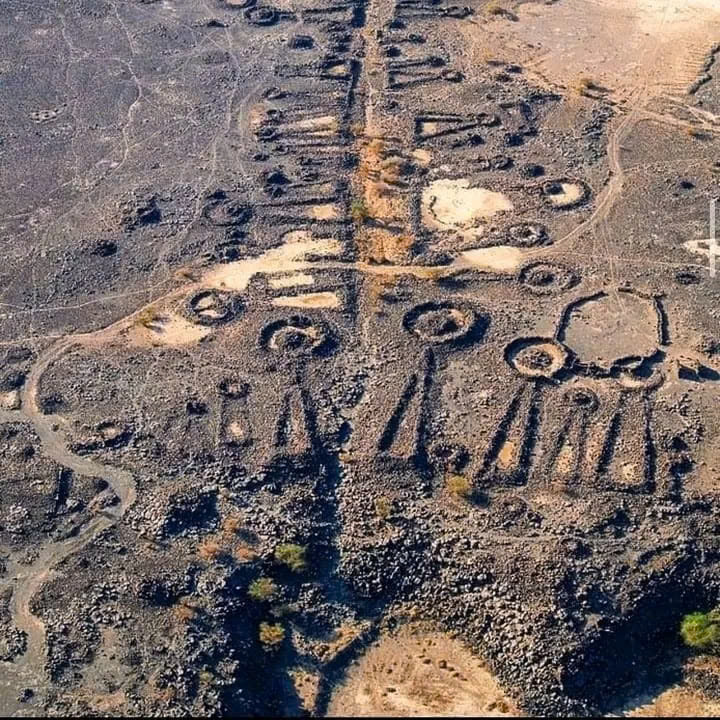In the heart of a vast desert landscape, where rolling dunes stretch endlessly and stone pathways weave through the barren terrain, an extraordinary discovery has shed light on civilizations long forgotten. Recent archaeological efforts have unveiled an intricate network of “funerary avenues” in northwest Saudi Arabia, offering an unparalleled glimpse into the lives, beliefs, and connections of Bronze Age societies. These ancient pathways are more than just remnants of the past; they are windows into a time when human ingenuity, resilience, and spirituality intertwined to create enduring legacies.

Spanning an astounding 160,000 square kilometers, this network of funerary avenues connects major oases such as AlUla, Khaybar, and Tayma. These routes are not mere trails but meticulously designed pathways, flanked by over 11,000 tombs, each a testament to the creativity and reverence of the communities that built them. As the desert winds continue to whisper the stories of these long-lost societies, researchers are piecing together the puzzle of their purpose and significance.
The funerary avenues, remarkable in their scale and design, were clearly more than just transportation routes. Archaeologists have proposed several theories to explain their creation, each shedding light on the multifaceted nature of these pathways. One possibility is that they served as ceremonial pathways, their alignment with carefully positioned tombs hinting at a profound spiritual significance. These routes may have been used for sacred processions, rituals, or pilgrimages, allowing ancient communities to express their beliefs and honor their ancestors in deeply meaningful ways.
Another theory suggests that the avenues were vital trade and communication networks, enabling the exchange of goods, ideas, and information across the challenging desert landscape. They may have facilitated the movement of people and livestock, connecting settlements and fostering economic and social ties between distant communities. Additionally, some researchers believe these pathways acted as territorial markers, delineating tribal boundaries and guiding herds to essential water sources and grazing lands during seasonal migrations. The multifunctional nature of the funerary avenues highlights the ingenuity and adaptability of Bronze Age societies as they navigated the harsh realities of their environment.
The tombs that line these pathways are architectural marvels, offering a glimpse into the advanced engineering and cultural sophistication of their creators. Dating back to between 2600 and 2000 BCE, the tombs display remarkable diversity in their design and construction. Ring cairns, for example, are circular stone mounds that served as burial chambers, reflecting a communal approach to honoring the dead. Pendant-shaped tombs, on the other hand, are more elaborate structures that may signify social status or familial prominence within the community. Each tomb, regardless of its design, represents a profound connection between the living and the deceased, underscoring the importance of ancestry and spirituality in these ancient societies.
The funerary avenues also reveal northwest Arabia as a critical cultural crossroads during the Bronze Age. This region served as a hub of interaction, connecting civilizations from Mesopotamia, the Levant, and other parts of the Arabian Peninsula. The construction of these avenues demonstrates the remarkable ability of these ancient societies to coordinate large-scale projects and navigate complex social, spiritual, and environmental landscapes. These pathways stand as evidence of a sophisticated understanding of their surroundings, as well as a commitment to creating enduring monuments that reflected their values and beliefs.
Today, the preservation and study of these funerary avenues have become a collaborative effort between the Royal Commission for AlUla (RCU) and international research teams. Utilizing cutting-edge technologies such as satellite imagery, ground-penetrating radar, and 3D mapping, researchers are unraveling the mysteries of these ancient pathways with unprecedented precision. These tools allow archaeologists to study the layout, construction, and use of the avenues without disturbing their delicate structures, ensuring that their legacy is preserved for future generations.
The efforts to understand and conserve these ancient pathways are not just about uncovering the past; they also hold valuable lessons for the present and future. The funerary avenues are a testament to humanity’s enduring relationship with the environment, showcasing how ancient societies adapted to and thrived in one of the world’s most unforgiving landscapes. They speak to the resilience, creativity, and spiritual depth of our ancestors, offering insights into how they found meaning and connection in the face of immense challenges.
As research progresses, these ancient pathways promise to reshape our understanding of human civilization. They highlight the ingenuity and adaptability of Bronze Age societies, challenging long-held assumptions about the capabilities and achievements of early humans. By studying the funerary avenues, archaeologists are uncovering stories of survival, connection, and cultural exchange that resonate across millennia, reminding us of the shared humanity that unites us with those who came before.
The funerary avenues of northwest Saudi Arabia are not just relics of the past—they are living testimonies to the enduring spirit of human creativity and resilience. They invite us to reflect on our own relationship with the environment, our connections with one another, and the legacies we leave behind. In the shifting sands of the Arabian desert, these pathways stand as a poignant reminder of the timeless quest for meaning, connection, and belonging that defines the human experience. As we continue to explore and preserve these remarkable monuments, they will undoubtedly inspire new generations to uncover the stories of our shared history and to celebrate the ingenuity and resilience of the human spirit.





